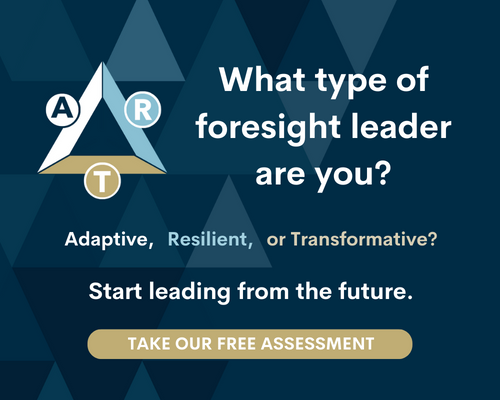Transformational Change With Qualitative Predictive Analysis

A couple of year’s ago, I wrote a short article entitled It’s Time To Democratize The Future. In the article I noted that, when talking about the future, many foresight practitioners, strategists, organizational designers, social scientists or human development professionals have either focused on the rise and impact of technology or sought to understand what future the majority of humanity hopes to see unfold.
In reality, neither of these approaches will help us to successfully navigate the uncertainty or unpredictability of a world in the throes of systemic corrosion, governmental incompetence, extreme social inequality, climate crisis or pandemic breakdown. As I stated in the aforementioned article, “What we should really be talking about is the mind-numbingly terrible job that leaders, social innovators and technologists have done of distributing the post-normal shift that is redefining life, work, communication, and humanity-at-large.” In other words, all of these failures are due to a lack of widespread actionable foresight — a way of thinking and being that serves to empower humanity’s evolution toward greater cooperation, collaboration and civilizational chrysalis.
Technology can support the transitions that are vital to humanity’s continual growth, but it isn’t the central mechanism by which we will solve our greatest challenges. Likewise, the future realities that people around the world hope to experience are also important, but those can often be a manifestation of “retro futures” or our collective resistance to change. Neither of these dynamics will save the future, but there is a more holistic approach that will.
When thinking about the future, it’s helpful to employ the metaphor of the “push and pull.” Imagining these two extremes can help us to understand how the future exists across a spectrum. Most often, when organizations, agencies, governments, and even consultants think about the future, they tend to focus on the trends that are arising and driving us to react; the disruptive forces to which we must adapt or die; and the emerging issues that are “pushing” us to respond whether we like it or not. Having lived for so long under systems that were designed to serve outdated linear processes and short-term “fight and flight” responses, we seldom acknowledge that there could be a much better way to deal with uncertainty and unpredictability than analyzing signals of change or brainstorming next-order ramifications. Though these practices are important for good futures and foresight work, they exist primarily at the “push” end of the futures spectrum. When we reside in these approaches, we reinforce our dominant narratives of the future that represent an extrapolation of present realities, the attempted recovery of “used futures,” or an expression of an “official future” that creates an ongoing, recursive loop of thinking and acting.
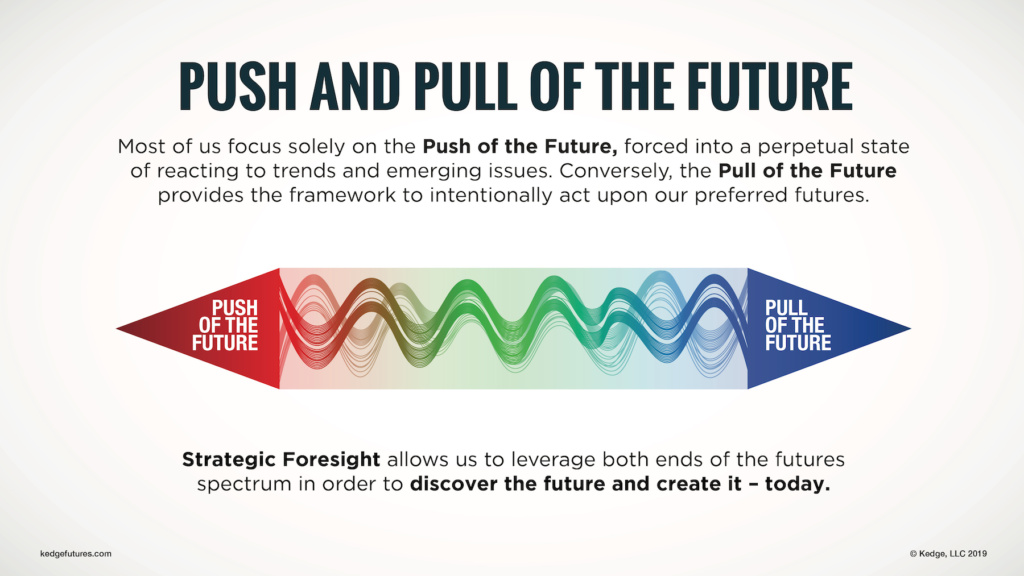
At the other end of this spectrum lies the “pull of the future,” and it’s this mode of meeting the challenge of uncertainty and unpredictability with which we are least familiar. Nonetheless, intentionally migrating toward the pull of the future allows us to break away from reductive thinking and construct novel ideas, solutions, models and opportunities. As futurist Ilkka Tuomi says, “The constructivist approach to foresight starts from the common sense observation that the future is not only repetition of the past. Innovation creates things that did not exist before. Social, cultural, and biological evolution and innovation therefore cannot be fully described using historical facts, concepts, or data… The future is not something to be known; indeed, it cannot be known as it does not exist yet. In the constructivist approach, the future is not known or understood; instead it is something to be created.” (1)
In other words, we will never be successful in navigating our way through uncertainty by only extrapolating historical data or exploring the possibilities that exist within our dominant narratives — our world is much too complex for such simple ways of thinking; we must move beyond adaptation or resilience as our response to the future, and begin cultivating a mindset of transformational change.
At this point, you may be wondering why a trained futurist — someone who (it is often believed) should be looking at the future and its possibilities through a completely agnostic lens — is touting the idea of transformational change. It is true that I look at the future from multiple angles, and acknowledge that many different futures can (and will) emerge. However, I also recognize that we are all creating the future everyday with the actions that we take, and I also know that the way we see the future directly impacts the actions we take today. This means that, in our use of foresight and futures thinking to tackle uncertainty, we must have the courage to imagine unique actions and outcomes if we hope to achieve aspirational visions for our organizations, governments and the planet. Old thinking will not produce new results — it will only produce more of the same and leave us vulnerable to the ticking time-bomb of large-scale problems. Those dilemmas cannot be avoided, solved or overcome from the “push” end of the future, but they can be forever altered by employing the “pull” of transformational change. As one organization noted, “Transformational change involves being more than doing. It is defined as ‘becoming something new, that has never before existed.’ It occurs in the context of how one thinks about what is happening. In other words, if I continue to think as I’ve always thought, I will act as I have always acted, and get what I have always gotten. Or, as the Chinese proverb declares ‘If I don’t change my direction, I will likely end up where I’m headed.’” (2)
In our work as futurists, we have sought to develop tools and methods to guide others toward the pull of transformational change, and one such tool that we have often used is what we call Qualitative Predictive Analysis™ (QPA). As the name of this tool suggests, we must become more comfortable with qualitative metrics that take us well beyond quantitative measurements if we are going to transform the systems that hold us captive to the breakdown of uncertainty and unpredictability. In order to democratize the future (or generate greater agency for individuals and communities across the world), we must instill a way of thinking that can sense how the nature of the future is changing. In QPA, a constructivist position is highlighted that takes into account the converging, integrated and holistic reality of the world around us. Such a tool looks past linear or reductive views of trends and data, and helps us to intuit the emerging values, patterns and impacts across multiples horizons of time. This transdisciplinary/post-disciplinary technique guides us toward the emergence of complexity rather than attempting to thwart it, and engenders a much more robust vision of transformative possibilities and actions.
At Kedge, we depict QPA as a series of cascading compounds across time, space and experience. As you can see in the graphic above, the work that we have done around analyzing data and trends (the “push of the future”) is initially used to determine our starting place that we call the Point of Manifestation (Cell 0). When we begin our climb up the cascading compounds of QPA, we start with a pattern (or what we refer to as “an emerging or manifesting landscape of change”) rather than a singular trend so as not to construct from a linear or overly simplistic viewpoint. In the real world, trends such as collaborative consumption or social robotics don’t exist in isolation. These trends — and many others — are colliding and converging with one another, and this creates patterns of change that are much larger and more comprehensively impactful than any singular trend or issue. As a matter of fact, it has often been said that scanning for trends is the lifeblood of good futuring or foresight. However, it is actually pattern recognition and exploration that is the real beating heart of such work. Identifying patterns is the first step in moving past trend extrapolation or forecasting, and into the practice of recognizing what is attempting to emerge or manifest. (If you are unfamiliar with pattern recognition and development, you can watch a brief tutorial here before beginning work on your own QPA compounds.)
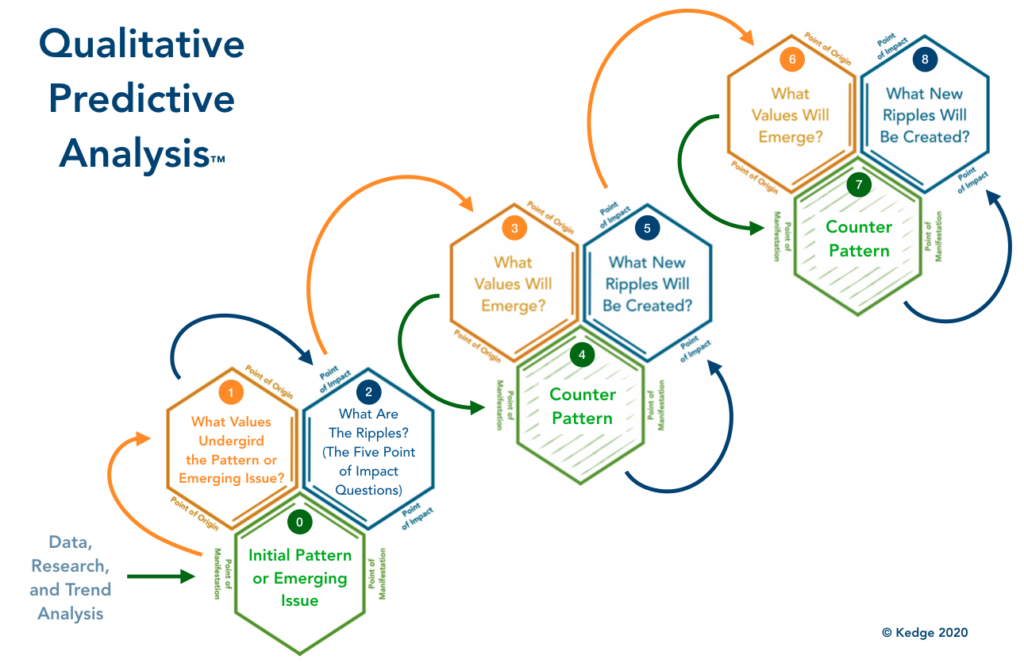
Once you have decided on the pattern that will be explored in Cell 0, you then begin identifying the values that under gird or support the emergence of that pattern in Cell 1. Value identification (or what we call the Point of Origin) is important because it displays why society is adopting this pattern — even if that embrace is not conscious or intentional — and what might potentially manifest or surface next based on the principles, beliefs and ideals of society.
Now that we have the push of the data and trends, our emerging pattern, and the underlying values, we can view them holistically to ask a series of questions about the unfolding impact on the way that we see the world and operate within it. (Cell 2). These Point of Impact questions, adapted from the VERGE model developed by Richard Lum and Michele Bowman (3), appear in the diagram below where we show how QPA was used with a client to construct transformative change around the pattern of Radical Life Extension.
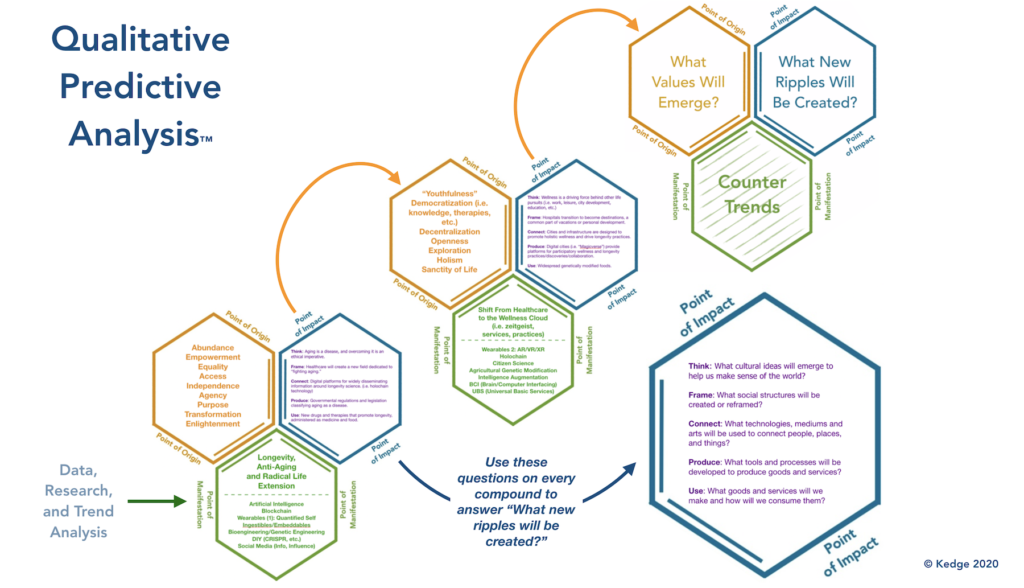
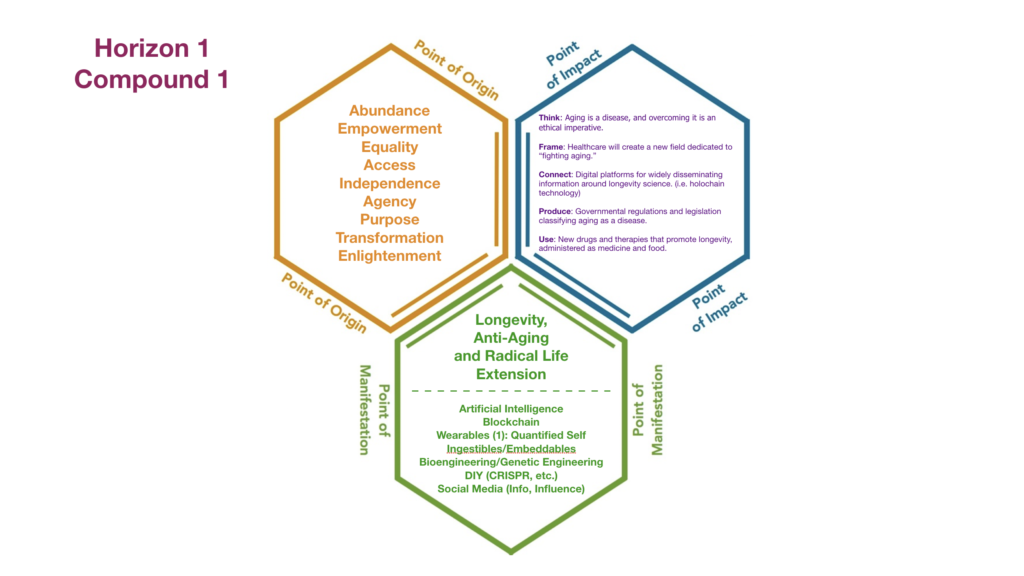
After completing the first compound, we are ready to transition to the second compound, However, we do not begin with the Point of Manifestation as we did in the first compound, but rather we explore the values that evolve from the picture painted by the entirety of that first compound (Cell 3). In this way, we set in place the foundational mindsets and social zeitgeist that give birth to the yet unknown Point of Manifestation (Cell 4). As you can see in our Radical Life Extension example, we also identified weak and fuzzy signals that stem from these new values and reinforce our new pattern. Lastly, we are ready to once again examine a new set of ripples in our Point of Impact (Cell 5).
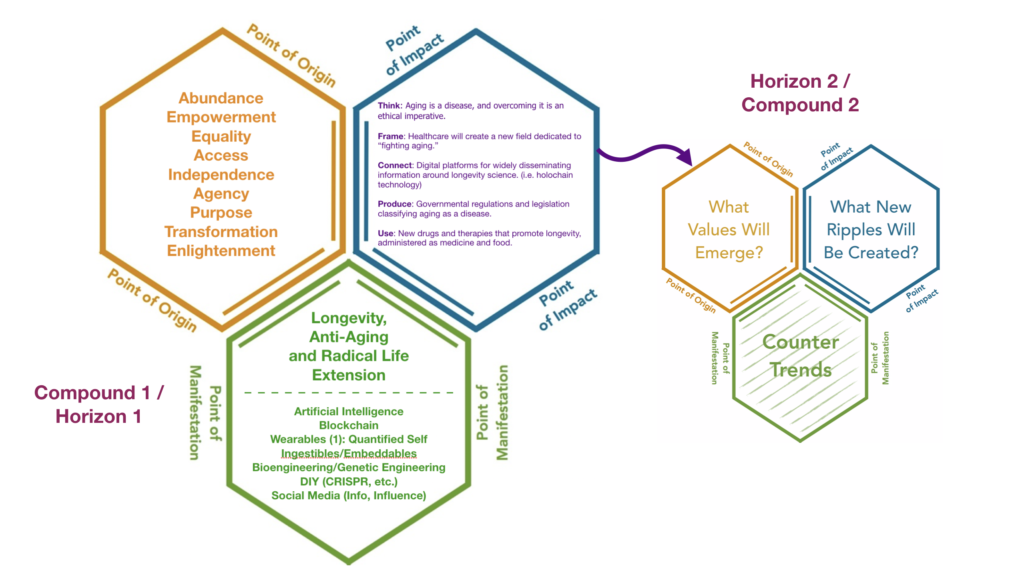
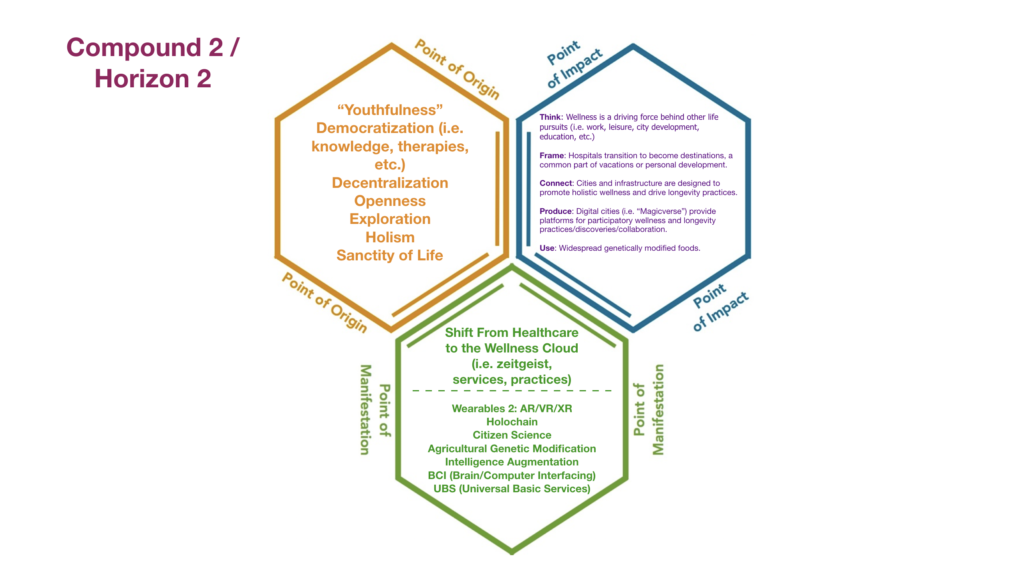
Now that Compound 1 and 2 are complete, we are ready to tackle the last part of the QPA model. Compound 3 is where our most provocative and transformative ideas will be revealed, and it is here that we will have broken past the merely plausible and possible realms of foresight into the transformative change needed to construct the future. Remember the diagram that depicted the “push and pull?” QPA has led us to design an entire spectrum of the future as it relates to one pattern or emerging landscape of change. We began with a near-term horizon, traveled to a mid-term horizon, and ultimately constructed a long-term horizon that allows us to break through to transformative change. (In the example below, Compound 3 is blank due to client IP, but this is a great opportunity for you to try your hand at constructing the future. What transformative values, patterns and impacts do you see emerging from this issue?)
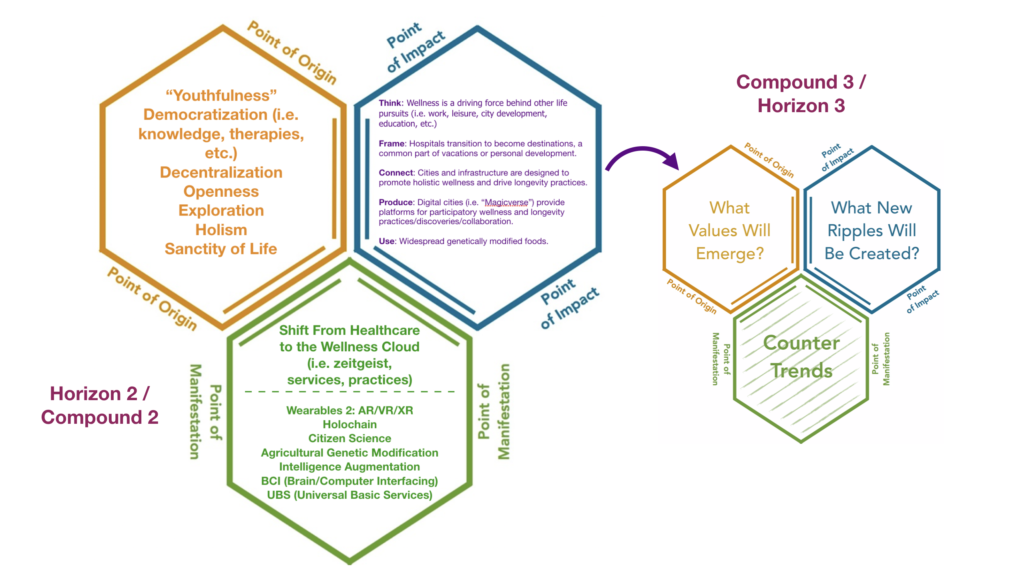
It will take some practice to move past a linear rendering of a QPA model of your own, but with time it will become second nature to move beyond thinking about the future as an extrapolation of the present that only needs more data to fill in the gaps, to understanding that in our world of exponential complexity, the nature of the future itself is changing. Old systems that were built on mindsets of linear thinking, simplistic viewpoints and predictable models are act as traps from which we cannot evolve past short-term strategies, fear-based governance and “fight and flight” reactions. In order to truly maneuver through the seas of uncertainty that are constantly rising around us, we must construct a vessel of transformative change that alters our vision of how the world actually works. The future may already be here, but it’s certainly being hidden beneath our attempts to continually distribute the past. If we want to save the future, we must transform.
1. https://onlinelibrary.wiley.com/doi/full/10.1002/ffo2.11
2. https://starr.org/transformational-vs-incremental-change/
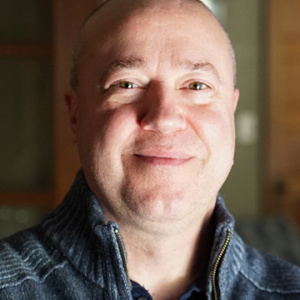
Frank Spencer
Co-Founder
Creative Director
In 2009, Frank founded Kedge – a global foresight, innovation, and strategic design firm which pioneered TFSX. Throughout his career, Frank has worked as a leadership coach and developer with entrepreneurs, social communities, networking initiatives, and SMEs, helping them in areas such as development, innovation, and networking.
Read More
